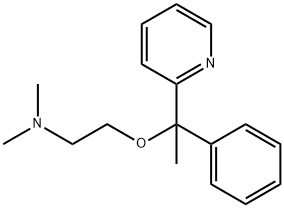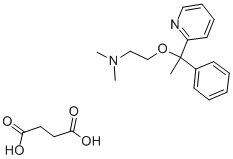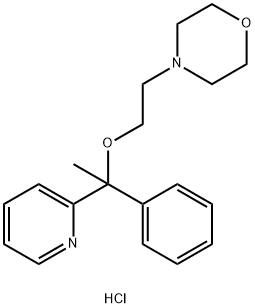DOXYLAMINE
- CAS NO.:469-21-6
- Empirical Formula: C17H22N2O
- Molecular Weight: 270.37
- MDL number: MFCD00599469
- EINECS: 207-414-2
- SAFETY DATA SHEET (SDS)
- Update Date: 2024-12-18 14:15:30

What is DOXYLAMINE?
Absorption
Readily absorbed via the gastrointestinal tract.
Toxicity
Signs of overdose include wheezing, tightness in the chest, fever, itching, bad cough, blue skin color, fits, swelling of face, lips, tongue, or throat.
The Uses of DOXYLAMINE
(±)-Doxylamine is an intermediate in the synthesis of Doxylamine N, N’-Dioxide (D562025), which is an impurity of Doxylamine (succinate salt, D562000), which is an H1 Histamine receptor antagonist.
The Uses of DOXYLAMINE
Antihistaminic.
Definition
ChEBI: Doxylamine is a member of pyridines and a tertiary amine. It has a role as a histamine antagonist, a cholinergic antagonist, a sedative, an antiemetic, a H1-receptor antagonist, an anti-allergic agent and an antitussive.
Background
Histamine H1 antagonist with pronounced sedative properties. It is used in allergies and as an antitussive, antiemetic, and hypnotic. Doxylamine has also been administered in veterinary applications and was formerly used in parkinsonism.
Indications
Used alone as a short-term sleep aid, in combination with other drugs as a night-time cold and allergy relief drug. Also used in combination with Vitamin B6 (pyridoxine) to prevent morning sickness in pregnant women.
brand name
Decapryn (Sanofi Aventis); Unisom (Pfizer).
General Description
Clear colorless liquid.
Reactivity Profile
DOXYLAMINE is an amine. Amines are chemical bases. They neutralize acids to form salts plus water. These acid-base reactions are exothermic. The amount of heat that is evolved per mole of amine in a neutralization is largely independent of the strength of the amine as a base. Amines may be incompatible with isocyanates, halogenated organics, peroxides, phenols (acidic), epoxides, anhydrides, and acid halides. Flammable gaseous hydrogen is generated by amines in combination with strong reducing agents, such as hydrides
Pharmacokinetics
Doxylamine is an antihistamine commonly used as a sleep aid. This drug is also used to relieve symptoms of hay fever (allergic rhinitis), hives (rash or itching), and other allergic reactions. Doxylamine is a member of the ethanolamine class of antihistamines and has anti-allergy power far superior to virtually every other antihistamine on the market, with the exception of diphenhydramine (Benadryl). It is also the most powerful over-the-counter sedative available in the United States, and more sedating than many prescription hypnotics. In a study, it was found to be superior to even the barbiturate, phenobarbital for use as a sedative. Doxylamine is also a potent anticholinergic.
Synthesis
Doxylamine is synthesized from phenyl-2- pyridinylmethyl carbinol and dimethylaminoethyl chloride in the presence of NaNH2 in xylene . It exhibits pronounced sedative effects. Therefore, doxylamine is mainly used as a sedative, a sleeping aid.
Metabolism
Hepatic.
Properties of DOXYLAMINE
| Melting point: | 25°C |
| Boiling point: | bp0.5 137-141° |
| Density | 1.0023 (rough estimate) |
| refractive index | 1.5486 (estimate) |
| storage temp. | -20°C Freezer, Under inert atmosphere |
| solubility | Acetonitrile (Slightly), Chloroform (Slightly), Methanol (Slightly) |
| form | Oil |
| pka | pKa 9.20(H2O
t = 25
c = 0.002–0.01) (Uncertain);4.4 (Uncertain);9.2 (Uncertain) |
| color | Colourless |
| Stability: | Temperature Sensitive |
| EPA Substance Registry System | Doxylamine (469-21-6) |
Safety information for DOXYLAMINE
| Signal word | Warning |
| Pictogram(s) |
 Exclamation Mark Irritant GHS07 |
| GHS Hazard Statements |
H302:Acute toxicity,oral H315:Skin corrosion/irritation H319:Serious eye damage/eye irritation H335:Specific target organ toxicity, single exposure;Respiratory tract irritation |
| Precautionary Statement Codes |
P261:Avoid breathing dust/fume/gas/mist/vapours/spray. P264:Wash hands thoroughly after handling. P264:Wash skin thouroughly after handling. P270:Do not eat, drink or smoke when using this product. P271:Use only outdoors or in a well-ventilated area. P280:Wear protective gloves/protective clothing/eye protection/face protection. P330:Rinse mouth. P362:Take off contaminated clothing and wash before reuse. P301+P312:IF SWALLOWED: call a POISON CENTER or doctor/physician IF you feel unwell. P302+P352:IF ON SKIN: wash with plenty of soap and water. P304+P340:IF INHALED: Remove victim to fresh air and Keep at rest in a position comfortable for breathing. P305+P351+P338:IF IN EYES: Rinse cautiously with water for several minutes. Remove contact lenses, if present and easy to do. Continuerinsing. P332+P313:IF SKIN irritation occurs: Get medical advice/attention. P337+P313:IF eye irritation persists: Get medical advice/attention. P405:Store locked up. P403+P233:Store in a well-ventilated place. Keep container tightly closed. P501:Dispose of contents/container to..… |
Computed Descriptors for DOXYLAMINE
DOXYLAMINE manufacturer
New Products
(S)-3-Aminobutanenitrile hydrochloride 4-Methylphenylacetic acid N-Boc-D-alaninol N-BOC-D/L-ALANINOL Tert-butyl bis(2-chloroethyl)carbamate 3-Morpholino-1-(4-nitrophenyl)-5,6-dihydropyridin- 2(1H)-one Furan-2,5-Dicarboxylic Acid Tropic acid 1-Bromo-3,5-Di-Tert-Butylbenzene S-2-CHLORO PROPIONIC ACID ETHYL ISOCYANOACETATE 2-Bromo-1,3-Bis(Dimethylamino)Trimethinium Hexafluorophosphate 4-IODO BENZOIC ACID 3-NITRO-2-METHYL ANILINE 1-(2,4-DICHLOROPHENYL) ETHANAMINE (2-Hydroxyphenyl)acetonitrile 4-Bromopyrazole 2-(Cyanocyclohexyl)acetic acid 4-methoxy-3,5-dinitropyridine 1-(4-(aminomethyl)benzyl)urea hydrochloride 2-aminopropyl benzoate hydrochloride diethyl 2-(2-((tertbutoxycarbonyl)amino) ethyl)malonate tert-butyl 4- (ureidomethyl)benzylcarbamate Ethyl-2-chloro((4-methoxyphenyl)hydrazono)acetateRelated products of tetrahydrofuran








You may like
-
 2033-24-1 98%View Details
2033-24-1 98%View Details
2033-24-1 -
 42831-50-5 5-METHYLISOXAZOLE-4-CARBOXYLIC ACID 98%View Details
42831-50-5 5-METHYLISOXAZOLE-4-CARBOXYLIC ACID 98%View Details
42831-50-5 -
 1975-50-4 98%View Details
1975-50-4 98%View Details
1975-50-4 -
 2-HYDROXY BENZYL ALCOHOL 98%View Details
2-HYDROXY BENZYL ALCOHOL 98%View Details
90-01-7 -
 2-Chloro-1,3-Bis(Dimethylamino)Trimethinium Hexafluorophosphate 221615-75-4 98%View Details
2-Chloro-1,3-Bis(Dimethylamino)Trimethinium Hexafluorophosphate 221615-75-4 98%View Details
221615-75-4 -
 61397-56-6 CIS BROMO BENZOATE 98%View Details
61397-56-6 CIS BROMO BENZOATE 98%View Details
61397-56-6 -
 14714-50-2 (2-Hydroxyphenyl)acetonitrile 98+View Details
14714-50-2 (2-Hydroxyphenyl)acetonitrile 98+View Details
14714-50-2 -
 118753-70-1 98+View Details
118753-70-1 98+View Details
118753-70-1